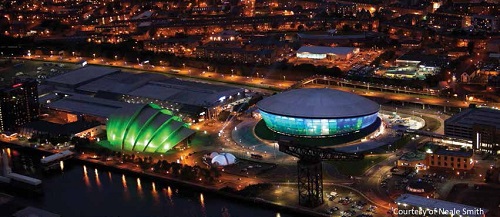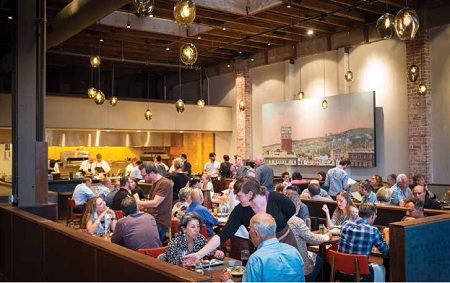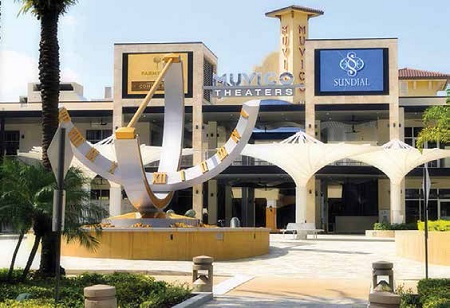Talking Past, Present, and Future with Industry Leaders


The Scottish Exhibition and Conference Center (SECC) located in Glasgow, Scotland, provides a wide range of conference, exhibition, and concert facilities. Recently, the SECC chose to upgrade the most commonly used venue, the Lomond Auditorium with Analog Way’s NeXtage 16, a powerful presentation mixer with soft edge-blending capabilities. The NeXtage 16 serves for the 12x4m projection screen fed by four Christie 8K projectors.As the New Year approaches, we tend to take the time to reflect on the past 12 months—what we accomplished, and what we hope to accomplish in the future. In the AV world, we’ve seen some technologies and applications flourish, with big buzzwords like collaboration, 4K, AV over IP, huddle room, the cloud, etc. popping up left and right. Here at SCN, we keep track of what trends the integrator needs to know throughout the year, but we thought the best way to wrap up the year in AV was to talk to the people leading the pack—that is, the manufacturers, engineers, sales people, and everyone else who watches this industry grow each day. Over the next few pages are discussions with these leaders on what trends they saw on the rise in 2015, what surprises they saw this year, and what they expect for 2016.

Franck Facon, Marketing and Communications Director, Analog Way
What technologies and/or verticals were most successful this year?
The AV display market remains the biggest winner of the year; however, the uses and needs have changed. LED walls are rapidly progressing in quality and finesse. They now allow a wide range of business applications for the integration and rental/staging markets. Costs remain high but are expected to decline rapidly in the next five years. Flat screens larger than 85 inches are now real alternatives to video projection for businesses, more so in 4K resolution. Collaborative solutions that include information sharing on BYOD are also growing.
Which do you see declining?
The video projection market has begun to decline. This should be accelerated with the rapid growth of cheaper, large flat screens and ultra-thin LED walls offered. Projectors will be maintained in a niche market intended for specific applications.
What technologies emerged this year that you were most surprised by? Were they effective?
A daily selection of the top stories for AV integrators, resellers and consultants. Sign up below.
BYOD has changed the way organizations operate. Everyone is now seeking the right solutions that would allow a perfectly seamless integration and collaboration for all AV and IT systems.
We have found that the first generation of systems was not perfect in terms of simplicity, connectivity, and operability. The next one will be more relevant and will meet the customers’ expectations. The convergence should be easier between IT and the AV systems.
What technologies/verticals should we keep our eye on for 2016?
Network technology could become a threat to AV manufacturers. HDBaseT and Dante exemplify precursors of the next revolution. Recently, many AV professionals have been seriously focusing on IT. In addition, it is clear that AV could be a formidable, attractive medium for the big giants of IT. BYOD could be seen as a Trojan Horse that could secure all business in meeting room environments. As a reminder, video players and other stand-alone devices have almost disappeared in less than 10 years in favor of laptops. The next step should be the decline of basic AV infrastructures in exchange for “intelligent” displays.
What customer/end-user demand surprised you the most this year and why?
The demand for simple switcher/scaler video processors—the fact is that there are already a vast number of “simple” (inexpensive) offerings in the market. Unfortunately, these products, of which the primary driving criteria is low pricing, leave many end users settling for less and, in the long run, having to add peripheral devices to compensate for the shortcomings of their “simple” low-cost switcher/scaler. As manufacturers of high-end products, we develop our solutions to provide differentiation by way of feature benefits, ease of use, elegance, and reliability. Although we are price conscious, our main criteria are quality and the ability to solve real market problems. We will not compromise on these.
What kinds of customer requests are becoming more common?
The request to keep it simple, including a strong visual UI and reliable performance. We know that powerful products remove user complexities when they are designed around simple-to-use graphical user interfaces and easy remote management capabilities. Moreover, we are convinced that future successful products must be more focused on actual user experience.

Peter Janis, President, Radial Engineering, Primacoustic, and Jensen
What technologies and/or verticals were most successful this year? Which do you see declining?
We have a number of brands, so this is somewhat difficult to answer. For the contractor market, we continue to enjoy greater sales results with Primacoustic as the market begins to realize the benefits. Acoustics have been around forever, but people are only beginning to realize how important they are when attempting to communicate. As for “successful technologies:” The Primacoustic Thundertile is a replacement ceiling tile, which provides absorption for speech attenuation while controlling sound energy escaping into other rooms via the plenum. Our sales are up 147 percent and our new Paintable Shapes Clouds are already generating substantial interest in the marketplace.

Peter Janis, president at Primacoustic, said one surprising customer demand he has seen this year is for acoustic treatment at dog daycares and animal shelters.What technologies emerged this year that you were most surprised by? Were they effective?
On the touring side of things, our USB Pro direct box has gained a lot of attention and with more and more laptops and tablets in use, we are seeing growing sales with our computer interface DI boxes.
What technologies/verticals should we keep our eye on for 2016?
Networking is certainly a key market for our various brands. The other, as mentioned before, is the integration of acoustic materials in venues. It seems that people are beginning to actually understand the problem and are becoming aware that there are solutions.
What customer/end-user demand surprised you the most this year and why? What kinds of customer requests are becoming more common?
With agencies like HIPPA and OSHA promoting doctor-patient confidentiality and reduced noise levels in the workplace, demand for acoustical products continues to grow. But surprising markets that have emerged are areas like dog daycare and animal shelters seeking noise relief. We are also seeing more interest from restaurants.

Scott Harkless, Director of Sales, Alcorn McBride
What technologies and/or verticals were most successful this year? Which do you see declining?
In general, the themed entertainment market is booming. This encompasses a wide variety of technical demands that lie just outside of the capabilities of mainstream AV and control technologies. Demands like tightly synchronized AV, lighting, and show control.
What technologies emerged this year that you were most surprised by? Were they effective?
Laser projection seems to be picking up some steam. Venues are constantly looking for ways to reduce maintenance cost and improve quality. Only time will tell if this is a lasting and effective trend.
What technologies/verticals should we keep our eye on for 2016?
Rapidly improving display technologies like LED walls, larger and higher-resolution LCD flat panels, and laser projection. Also, the playback technologies required to fill them with interesting content.
What customer/end-user demand surprised you the most this year and why? What kinds of customer requests are becoming more common?
The migration of more onboard AV for transportation and ride vehicles—this introduces many unique challenges that mainstream AV gear is not designed to handle.

Robin Dibble, Product Support Engineer, Martin Audio
What technologies and/or verticals were most successful this year? Which do you see declining?
For us, the installation market has been particularly strong this year, as we have introduced our CDD range featuring coaxial differential dispersion technology into this marketplace. It’s opened up more opportunities for us across a range of applications including houses of worship, bars, restaurants, retail stores, and nightclubs. This has had the knock-on effect of both widening our customer base and enabling existing worldwide distribution partners to grow their business in this sector.
As always, we have seen continued growth with our MLA series, as issues such as uniform and exceptional audio quality for every member of the audience, noise pollution control, and power consumption become more important considerations worldwide. Powered loudspeaker products generally appear to be on the increase too.
In terms of decline, we have seen macro challenges with the likes of the Chinese economy and government policies affecting the growth of nightclubs, and the continual closure of “live event” venues in the UK means that sector is challenging. Regarding technologies, the demise of analog mixing and audio processing continues, as the cost of going digital continues to fall, and the benefits continue to increase.

A Martin Audio MLA system was installed this year at the Calvary Church in Charlotte, NC.What technologies emerged this year that you were most surprised by? Were they effective?
We have been surprised by the success of our CDD (coaxial differential dispersion) technology. We felt we had delivered something strong and new to the sector, and at a competitive price, but the demand was double our forecast, so it’s taken us some time to catch up production-wise, but we seem to be in a good space now moving forward.
Elsewhere in the marketplace, there hasn’t been much new in our sector—except there seems to be even wider adoption of the advantages of electronically controlling the coverage of large-scale audio systems.
The common thread with all new technology loudspeaker systems seems to be an increase in the use of powered loudspeakers of all shapes and sizes, with network and control on board. This is a concept that I personally fully agree with: treating the reproduction device as a single system, rather than separate amplifier, processor, and transducer can only result in improvements in system performance.
What technologies/verticals should we keep our eye on for 2016?
I am expecting to see further opportunities for increased creativity, flexibility, and performance through the deployment of digital audio technology. As processors become faster, and costs reduce, who knows what will come next? The only limit will be our imagination as more and more tools become available to us.
What customer/end-user demand surprised you the most this year and why? What kinds of customer requests are becoming more common?
We are increasingly asked for unique solutions to achieve exceptional or unusual goals for end users, integrators, and the artistic community. This could be simply in terms of product color and mounting, or requests for highly customized specialist or one-off solutions.

Clint Hoffman, Vice President of Marketing, Kramer Electronics US
What technologies and/or verticals were most successful this year? Which do you see declining?
Wireless presentation, collaboration, and cloud-based control were the hottest technologies in 2015, and we see those technologies continuing to be the hot spots in the market in 2016. The most successful vertical markets in 2015 have been higher education, corporate, and house of worship (in that order), and we see that also continuing in 2016.
What technologies emerged this year that you were most surprised by? Were they effective?
Cloud-based control is growing much faster than we expected, and we couldn’t be more pleased. We have had a number of very successful installations that have employed cloud-based control, and we can see tremendous future growth for this powerful, easy-to-use, and affordable control solution.
What technologies/verticals should we keep our eye on for 2016?
The next big technology in our market is AV over IP for signal distribution. As for verticals, I think the K-12 market will be able to grow significantly in 2016 due to the new economical wireless presentation and collaboration solutions introduced to the market, and because of cloud-based control, which allows sophisticated control to be done very economically. The K-12 market is very price sensitive for a good reason, and now these new advanced solutions are within reach of that market.
What customer/end-user demand surprised you the most this year and why? What kinds of customer requests are becoming more common?
Because we could see the opportunity—and thus demand—for wireless presentation and collaboration solutions for all verticals that have meeting spaces, it was the rapid acceptance and adoption of cloud-based control solutions that most surprised us. We know this is a great tool allowing full room integration and control today, and that it will be the staple of control market in the future, but we were not expecting it to be in such high demand right out of the gate. It is very exciting, not only for us, but for the pro AV market itself.

Steve Seminario, Senior Director of Product Marketing, Planar Systems
What technologies and/or verticals were most successful this year? Which do you see declining?
Our big winners this year were video walls and large-format commercial 4K displays. For corporate, government, and university customers, we saw continued strong growth of our ultra-narrow bezel LCD video wall line, Clarity Matrix, our commercial large-format 4K line, Planar UltraRes, and faster-than-expected emergence of fine-pitch LED video wall demand around our DirectLight LED Video Wall System. Within the UltraRes and Matrix lines, we had particularly high attach rates for MultiTouch versions.
What technologies emerged this year that you were most surprised by? Were they effective?
We launched our first fine-pitch direct view LED video wall product line, DirectLight, with high expectations, but we were frankly surprised by the significant number of serious deals emerging from our reseller partners across verticals. It indicated a level of awareness and interest in the fine-pitch, seamless LED video wall technology that exceeded our expectations, as well as a positive market response to our particular product design.
What technologies/verticals should we keep our eye on for 2016?
The emergence of fine-pitch LED video walls will continue to accelerate quickly in the market. In addition, we see the adoption of second-generation commercial 4K displays, such as our newly introduced UltraRes 75 inch, 84 inch, and 98 inch, continuing on the fast growth pace we saw with first-generation 4K products last year.
What customer/end-user demand surprised you the most this year and why? What kinds of customer requests are becoming more common?
For creating totally seamless indoor displays that were both high resolution and very large screen area, large single or edge-blended projectors were the only solution. But projection solutions come with a number of disadvantages that are well understood in the industry. We expected that fine-pitch direct view LED, coming in the right product design from a trusted manufacturer, would provide an excellent alternative for customers looking for large, seamless screens. What surprised us was how many end-user organizations had already made this connection and were looking for solutions.

John McMahon, Vice President, Solutions and Strategy, Meyer Sound
What technologies and/or verticals were most successful this year? Which do you see declining?
The use of our acoustic technology in restaurants was a big new area of growth for Meyer Sound this year. The application of the Constellation acoustic system combined with Libra acoustic image panels has revolutionized the way that people experience their dining pleasures: it has reduced the distractions of typical restaurant noise while maintaining the buzz and atmosphere that a restaurant needs to have. It’s a very hot topic right now—so hot that The New York Times and The New Yorker even picked this up.
What technologies emerged this year that you were most surprised by? Were they effective?
We knew there was an issue with restaurant noise. We all dine at restaurants and all suffer the incredible din that exists at certain restaurants. While the food and service may be amazing, if it’s too loud, it’s really uncomfortable and hard to have dialogue with your tablemate. This new technology in this area is not a surprise, but I am surprised at how much external interest there has been. There have been days where our phone hasn’t stopped ringing with people wanting to hear more about the Constellation technology.

The Meyer Constellation acoustic system is a hit in restaurants, said John McMahon, vice president, solutions and strategy at Meyer. Shown here, The Advocate restaurant in Berkeley, CA, which recently installed a Constellation system.What technologies/ verticals should we keep our eye on for 2016?
We are seeing a lot of growth in the use of Constellation technology in other spaces, including classrooms and corporate boardrooms, and there are many new applications for the acoustic control technology that range way beyond the typical application for this type of system.
What customer/end-user demand surprised you the most this year and why?
One of the big surprises for us was the demand for this type of technology in corporate spaces. We developed it initially to solve the needs of restaurants, but those same needs exist in many meeting rooms and boardrooms—this has been a big surprise. There are projects happening now where architects are thinking about the acoustic and sonic experience, not just the visual and functional experience of a space. With the Constellation technology, we can deliver new experiences in a dimension that architects weren’t able to control in the past.
What kinds of customer requests are becoming more common?
Flexibility, integrated systems, cinema, sound reinforcement, acoustics— all being bundled into one system. Our customers demand systems that can provide the functionality across a lot of different applications all within the same system. We’re seeing a big demand there for fully integrated systems.

Vinnie Macri, Product Marketing Manager, Clear-Com
What technologies and/or verticals were most successful this year? Which do you see declining?
With the ever-growing acceptance of audio on IP networks, we have experienced a very successful year across all of our IP product offerings. This year proved interesting, specifically with our uncomplicated LQ line of audio/intercom-to-IP devices. LQ was developed using the OPUS codec expressly to offer users options to use either a WAN, LAN, or internet as a transport medium. Most audio codecs, while possibly offering a set of data compression algorithms, apply the settings to all audio ports. The LQ offers adjustable network settings for bit rates, packet size, and jitter on a per-port, per-send, per-receive basis.
What technologies emerged this year that you were most surprised by? Were they effective?
I didn’t see any new technologies with regard to production intercom other than the presence of continued acceptance of IP workflows. They are as effective as the user’s understanding of the benefits and drawbacks, and how to apply them. If one believes that the reasoning for audio IP networks is economics, then he or she is misinformed.
What technologies/verticals should we keep our eye on for 2016?
I think the most interesting company to watch is Cisco, as it has since 2012 gotten behind AVB with deterministic ethernet, time-sensitive networking.
What kind of customer requests are becoming more common?
The use of the internet! Recognizing remote productions is far different than installed sound, where a facility is transporting audio locally and a LAN might be appropriate, and remote productions that might be geographically separated by continents. The cost of leased circuits is prohibitively high. In remote sports production at the college level, the use of the internet for video and audio is common from the venue to the broadcaster.

Michael Bridwell, Vice President, Marketing and Home Entertainment, Digital Projection Inc.
What technologies and/or verticals were most successful this year? Which do you see declining?
Solid-state illumination continues to utterly transform the projection environment, and that is no surprise. There are too many points of value within these illumination solutions to ignore. We’ve seen an almost insatiable demand for demo requests in all manner of venues. From a declining trend perspective, any commercial projector that is underwhelming from a brightness perspective better be either exceptionally specialized or very inexpensive these days.
What technologies emerged this year that you were most surprised by? Were they effective?
High-quality content creation continues to be a critical component of the visual experience, and new solutions are emerging every day. I hope that continues.
What technologies/verticals should we keep our eye on for 2016?
Watch commercial and corporate verticals that are more data driven and less entertainment oriented. Many of them are gradually realizing the benefits to upgrading their display’s resolution. Here’s an example: I recently participated in a demo where the client was considering upgrading their two lamp-illuminated 1080p projectors to 4K laser-hybrid projectors. The initial interest emerged from the long-life laser illumination that would, due to their high use, lessen their illumination maintenance and costs. Video content looked good. But what really captured the client’s attention was when they saw their own PowerPoint presentation on both the 4K and 1080p, they could immediately see the clearer, more legible presentation content. And that will be a valuable experience upgrade for everyone that participates. You’ll see more of that realization in 2016.
What customer/end-user demand surprised you the most this year and why? What kinds of customer requests are becoming more common?
The demand for 4K displays continues to surprise me, especially in verticals primarily displaying video content at a distance from the audience. I understand the desire to “future proof” when making an investment, but my hope is that end users find solid integration partners that steer them toward projectors that truly accomplish the goals of the venue. Resolution is simply one potential aspect of an effective image; there are so many other things to take into consideration. My advice to end users is first commit to how you want to use the venue you have—what is essential to the audience experience, and what is more aspirational—then, align the budget to the essentials.

Fred Bargetzi, Chief Technology Officer, Crestron
What technologies and/or verticals were most successful this year? Which do you see declining?
4K video has been a huge hit this year, as display prices have dropped and users see the value in high-quality content. It just doesn’t make sense to put in 1080p systems anymore. Another big technology hit has been H.264 video. H.264 is the best way to do streaming video in AV systems today—it has low bandwidth needs so you can put it on a non-specialized network, it is also cross compatible across a large number of systems and has a great price point.
What technologies emerged this year that you were most surprised by? Were they effective?
Bluetooth is not a new technology, but it is becoming a very important one. A newer standard called Bluetooth Low Energy (BTLE) enables our devices that we carry with us all the time to know where we are, and through that, personalize your controls. Users will be able to interact with their spaces in a much more familiar way by using their own devices. This helps us to revolutionize the experience we deliver.
What technologies/ verticals should we keep our eye on for 2016?
The Internet of Things is a technology concept that will come very quickly to our industry. Every device will be connected to a single platform to provide a consistent experience and support structure.
What customer/ end user demand surprised you the most this year and why? What kind of customer requests are becoming more common?
Customers are is expecting more from our industry every day. They are expecting their systems to be more intelligent, to learn and react over time. They are also expecting to do everything they want from their own devices. They are expecting everything to be network connected—and not just any network connection, but the most powerful, enterprise-grade security available—meaning 802.1x, active directory integration and more.
Ultimately, they expect us to deliver an experience that is far greater than before—and they want it everywhere. The conversations are no longer about ports and boxes, but more importantly, what experience can we deliver and how do we make it cost effective to deploy in every space—not just the premium ones.

John Sexton, Director of Sales, Ashly Audio
What technologies and/or verticals were most successful this year? Which do you see declining?
High-growth vertical markets in 2015 were restaurants, retail and hospitality, K-12 education, and government. Growth in the audio portion of the worship market appears to be fairly flat this year. From a product and technology standpoint, we continue to grow our amplifier business via our new NX power amplifiers, as well as our extensive lineup of Dante-ready power amplifiers (42 models and counting).
In the retail channel, sales have migrated toward powered loudspeakers and away from standalone rack-mounted power amps and DSPs.
What technologies emerged this year that you were most surprised by? Were they effective?
I believe the entire audio industry has been surprised by the accelerated adoption rate of Dante as the de facto network transport. Dante works as advertised. We offer 42 different amplifiers that accept a Dante network card, ranging from four channels at 3,000 watts per channel, down to an eight-channel model at 250 watts or 125 watts per channel. When it comes to Dante, Ashly is “all in.”

Ashly amplifiers and processors were the choice for Sundial, an open-air shopping center in St. Petersburg, FL.What technologies/verticals should we keep our eye on for 2016?
Integrators are learning that Dante is a cost-effective solution in medium-size worship and auditorium projects. The Dante-equipped digital console feeds the Dante-equipped Ashly amplifiers over a Cat-5 cable. In an existing facility, pulling primary and secondary Cat-5 cables presents a real cost savings over a traditional analog system. The digital highway is a feasible alternative, even in projects with moderate budgets.
What customer/end-user demand surprised you the most this year and why? What kinds of customer requests are becoming more common?
I can’t say we were surprised, but we continue to see strong growth in multi-channel and networked power amplifiers. Rack density— maximizing the number of amplifier channels in the fewest rack spaces—lowers cost to the end users while delivering improved energy efficiency. Ashly has long preached the value of network audio, particularly as integrators view service contracts as sources of recurring revenue.
